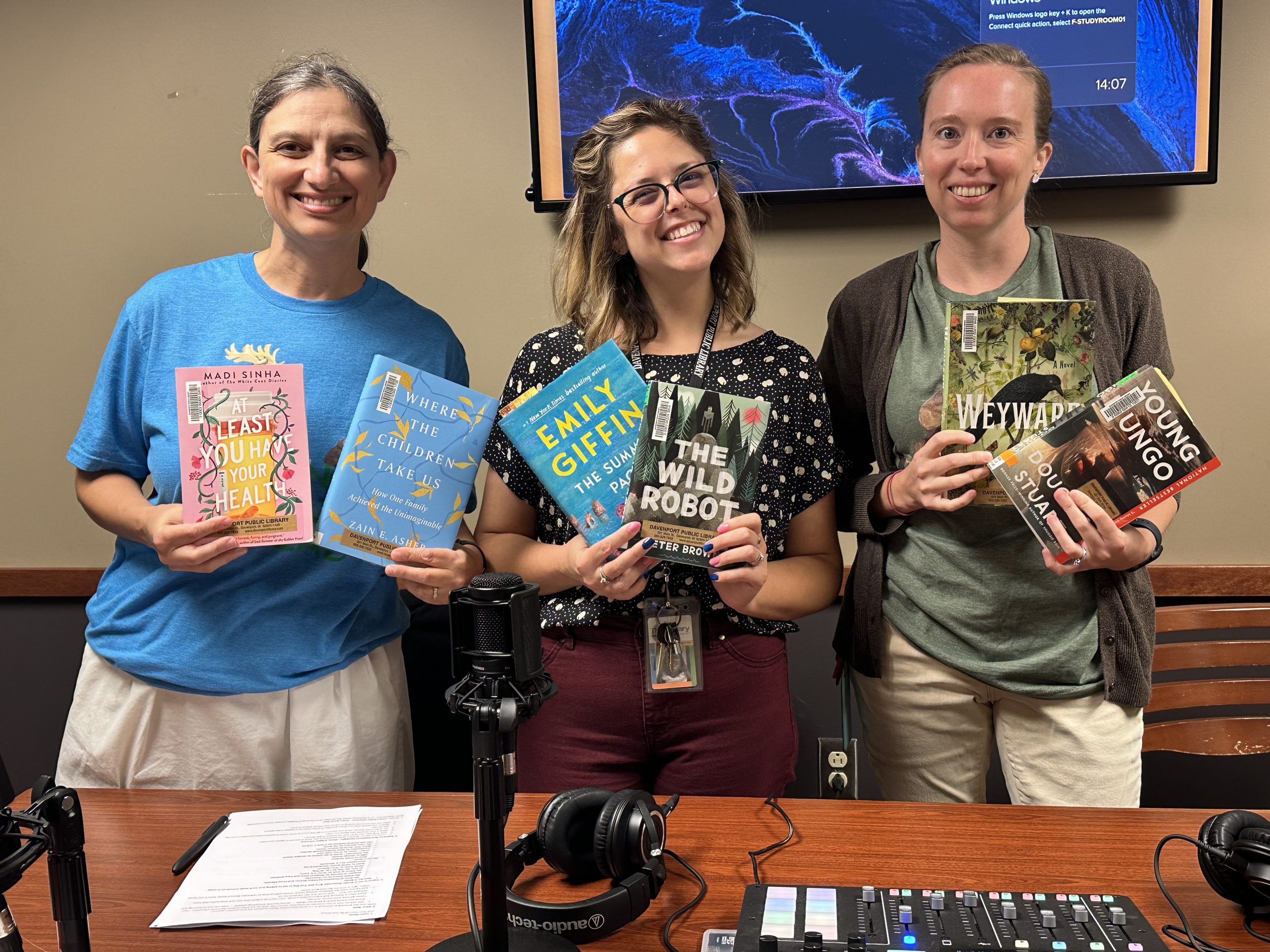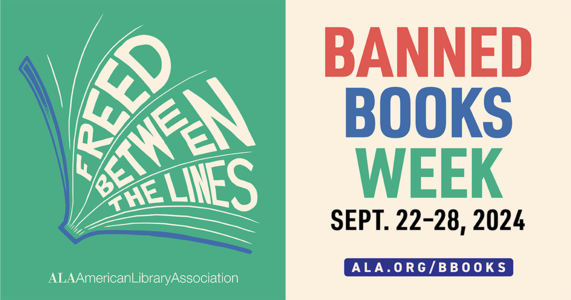Banned Book Week 2025 is finally here! Running from October 5th through October 11th, 2025, the theme for this year is ‘Censorship is So 1984 – Read for Your Rights’. According to the American Library Association, ‘With the escalation in attempts to ban books in libraries, schools, and bookstores around the country, George Orwell’s cautionary tale “1984” serves a prescient warning about the dangers of censorship. This year’s theme reminds us that the right to read belongs to all of us, that censorship has no place in contemporary society, and that we must defend our rights.’
Below are the Top 10 Most Challenged Books of 2024 (Descriptions are provided by the publishers.):
1. All Boys Aren’t Blue by George M. Johnson
 Why this book matters: bit.ly/allboysBR
Why this book matters: bit.ly/allboysBR
In a series of personal essays, award-winning author and LGBTQIA+ activist George M. Johnson’s All Boys Aren’t Blue explores their childhood, adolescence, and college years in New Jersey and Virginia.
From the memories of getting his teeth kicked out by bullies at age five, to flea marketing with his loving grandmother, to his first sexual relationships, this young-adult memoir weaves together the trials and triumphs faced by Black queer boys.
Both a primer for teens eager to be allies as well as a reassuring testimony for young queer men of color, All Boys Aren’t Blue covers topics such as gender identity, toxic masculinity, brotherhood, family, structural marginalization, consent, and Black joy. Johnson’s emotionally frank style of writing will appeal directly to young adults. (Johnson used he/him pronouns at the time of publication.) – Farrar, Straus and Giroux
2. Gender Queer by Maia Kobabe
 Why this book matters: bit.ly/genderBR
Why this book matters: bit.ly/genderBR
In 2014, Maia Kobabe, who uses e/em/eir pronouns, thought that a comic of reading statistics would be the last autobiographical comic e would ever write. At the time, it was the only thing e felt comfortable with strangers knowing about em. Now, Gender Queer is here. Maia’s intensely cathartic autobiography charts eir journey of self-identity, which includes the mortification and confusion of adolescent crushes, grappling with how to come out to family and society, bonding with friends over erotic gay fanfiction, and facing the trauma and fundamental violation of pap smears.
Started as a way to explain to eir family what it means to be nonbinary and asexual, Gender Queer is more than a personal story: it is a useful and touching guide on gender identity—what it means and how to think about it—for advocates, friends, and humans everywhere. – Oni Press
3. (TIE) The Bluest Eye by Toni Morrison
 Why this book matters: bit.ly/bluestBR
Why this book matters: bit.ly/bluestBR
From the acclaimed Nobel Prize winner—a powerful examination of our obsession with beauty and conformity that asks questions about race, class, and gender with characteristic subtlety and grace.
In Morrison’s acclaimed first novel, Pecola Breedlove—an 11-year-old Black girl in an America whose love for its blond, blue-eyed children can devastate all others—prays for her eyes to turn blue: so that she will be beautiful, so that people will look at her, so that her world will be different. This is the story of the nightmare at the heart of her yearning, and the tragedy of its fulfillment. – Vintage
3. (TIE) The Perks of Being a Wallflower by Stephen Chbosky
 Why this book matters: bit.ly/wallflowerBR
Why this book matters: bit.ly/wallflowerBR
The critically acclaimed debut novel from Stephen Chbosky follows observant “wallflower” Charlie as he charts a course through the strange world between adolescence and adulthood. First dates, family drama, and new friends. Sex, drugs, and The Rocky Horror Picture Show. Devastating loss, young love, and life on the fringes. Caught between trying to live his life and trying to run from it, Charlie must learn to navigate those wild and poignant roller-coaster days known as growing up.
A #1 New York Times bestseller for more than a year, adapted into a major motion picture starring Logan Lerman and Emma Watson (and written and directed by the author), and an American Library Association Best Book for Young Adults (2000) and Best Book for Reluctant Readers (2000), this novel for teen readers (or wallflowers of more-advanced age) will make you laugh, cry, and perhaps feel nostalgic for those moments when you, too, tiptoed onto the dance floor of life. – MTV Books
5. Tricks by Ellen Hopkins
 Why this book matters: bit.ly/tricksBR
Why this book matters: bit.ly/tricksBR
When all choice is taken from you, life becomes a game of survival.
Five teenagers from different parts of the country. Three girls. Two guys. Four straight. One gay. Some rich. Some poor. Some from great families. Some with no one at all. All living their lives as best they can, but all searching…for freedom, safety, community, family, love. What they don’t expect, though, is all that can happen when those powerful little words “I love you” are said for all the wrong reasons.
Five moving stories remain separate at first, then interweave to tell a larger, powerful story—a story about making choices, taking leaps of faith, falling down, and growing up. A story about kids figuring out what sex and love are all about, at all costs, while asking themselves, “Can I ever feel okay about myself?” – Margaret K. McElderry Books
6. (TIE) Looking for Alaska by John Green
 Why this book matters: bit.ly/alaskaBR
Why this book matters: bit.ly/alaskaBR
First drink. First prank. First friend. First love.
Last words.
Miles Halter is fascinated by famous last words—and tired of his safe life at home. He leaves for boarding school to seek what the dying poet François Rabelais called the “Great Perhaps.” Much awaits Miles at Culver Creek, including Alaska Young, who will pull Miles into her labyrinth and catapult him into the Great Perhaps.
Looking for Alaska brilliantly chronicles the indelible impact one life can have on another. A modern classic, this stunning debut marked #1 bestselling author John Green’s arrival as a groundbreaking new voice in contemporary fiction. – Penguin Books
6. (TIE) Me and Earl and the Dying Girl by Jesse Andrews
 Why this book matters: bit.ly/earlBR
Why this book matters: bit.ly/earlBR
This is the funniest book you’ll ever read about death.
It is a universally acknowledged truth that high school sucks. But on the first day of his senior year, Greg Gaines thinks he’s figured it out. The answer to the basic existential question: How is it possible to exist in a place that sucks so bad?
His strategy: remain at the periphery at all times. Keep an insanely low profile. Make mediocre films with the one person who is even sort of his friend, Earl.
This plan works for exactly eight hours. Then Greg’s mom forces him to become friends with a girl who has cancer. This brings about the destruction of Greg’s entire life.– Amulet Books
8. (TIE) Crank by Ellen Hopkins
 Why this book matters: bit.ly/crankBR
Why this book matters: bit.ly/crankBR
Life was good
before I
met
the monster.
After,
life
was great,
At
least
for a little while.
Kristina Snow is the perfect daughter: gifted high school junior, quiet, never any trouble.
Then, Kristina meets the monster: crank. And what begins as a wild, ecstatic ride turns into a struggle through hell for her mind, her soul—her life.
8. (TIE) Sold by Patricia McCormick
 Why this book matters: bit.ly/soldBR
Why this book matters: bit.ly/soldBR
The powerful, poignant, bestselling National Book Award finalist gives voice to a young girl robbed of her childhood yet determined to find the strength to triumph.
Lakshmi is a thirteen-year-old girl who lives with her family in a small hut on a mountain in Nepal. Though desperately poor, her life is full of simple pleasures, like playing hopscotch with her best friend from school, and having her mother brush her hair by the light of an oil lamp. But when the harsh Himalayan monsoons wash away all that remains of the family’s crops, Lakshmi’s stepfather says she must leave home and take a job to support her family.
He introduces her to a glamorous stranger who tells her she will find her a job as a maid in the city. Glad to be able to help, Lakshmi journeys to India and arrives at “Happiness House” full of hope. But she soon learns the unthinkable truth: she has been sold into prostitution.
An old woman named Mumtaz rules the brothel with cruelty and cunning. She tells Lakshmi that she is trapped there until she can pay off her family’s debt-then cheats Lakshmi of her meager earnings so that she can never leave.
Lakshmi’s life becomes a nightmare from which she cannot escape. Still, she lives by her mother’s words—Simply to endure is to triumph—and gradually, she forms friendships with the other girls that enable her to survive in this terrifying new world. Then the day comes when she must make a decision-will she risk everything for a chance to reclaim her life?
Written in spare and evocative vignettes by the co-author of I Am Malala (Young Readers Edition), this powerful novel renders a world that is as unimaginable as it is real, and a girl who not only survives but triumphs. – Little, Brown Books for Young Readers
10. Flamer by Mike Curato
 Why this book matters: bit.ly/flamerBR
Why this book matters: bit.ly/flamerBR
I know I’m not gay. Gay boys like other boys. I hate boys. They’re mean, and scary, and they’re always destroying something or saying something dumb or both.
I hate that word. Gay. It makes me feel . . . unsafe.
It’s the summer between middle school and high school, and Aiden Navarro is away at camp. Everyone’s going through changes—but for Aiden, the stakes feel higher. As he navigates friendships, deals with bullies, and spends time with Elias (a boy he can’t stop thinking about), he finds himself on a path of self-discovery and acceptance. – Henry Holt and Co. (BYR)

 The Library now has
The Library now has  Have you been meaning to learn a new language or polish those sophomore year Spanish skills?
Have you been meaning to learn a new language or polish those sophomore year Spanish skills?  Celebrate Banned Books Week!
Celebrate Banned Books Week!
























 The Catcher in the Rye, by J.D. Salinger
The Catcher in the Rye, by J.D. Salinger The Grapes of Wrath, by John Steinbeck
The Grapes of Wrath, by John Steinbeck To Kill a Mockingbird, by Harper Lee
To Kill a Mockingbird, by Harper Lee The Color Purple, by Alice Walker
The Color Purple, by Alice Walker Ulysses, by James Joyce
Ulysses, by James Joyce Beloved, by Toni Morrison
Beloved, by Toni Morrison The Lord of the Flies, by William Golding
The Lord of the Flies, by William Golding 1984, by George Orwell
1984, by George Orwell Lolita, by Vladmir Nabokov
Lolita, by Vladmir Nabokov Of Mice and Men, by John Steinbeck
Of Mice and Men, by John Steinbeck Are you interested in participating in Banned Books Week, but don’t know how? Consider joining many celebrities, libraries and bookstores across the country in the Banned Books Virtual Read-Out!
Are you interested in participating in Banned Books Week, but don’t know how? Consider joining many celebrities, libraries and bookstores across the country in the Banned Books Virtual Read-Out!


